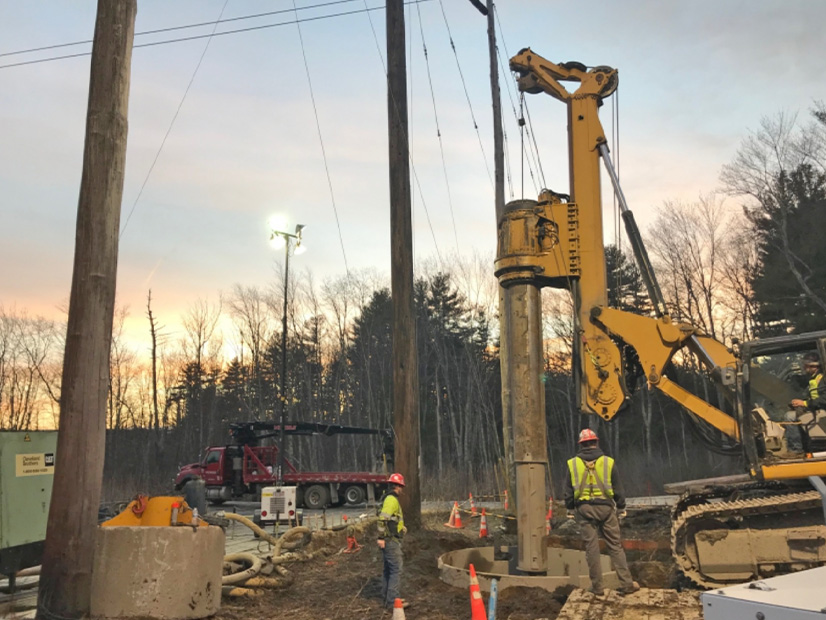 Steve Huntoon | Steve Huntoon
Steve Huntoon | Steve HuntoonYou young’uns don’t know, but back in the Middle Ages of the 1970s there was a famous commercial for Fram oil filters: You could pay the Fram guy $4 for an oil filter now or pay hundreds for engine repairs later.[1]
Having slightly less pizzazz is the question of how consumers pay for transmission project costs during the pre-construction and construction phases, i.e., before they are completed and placed in service. Consumers can pay a transmission owner’s return (aka cost of capital, aka carrying charge) on such costs on a current basis before and during construction (pay now) or start to pay that return when the project is completed (pay later). The former is often called the “construction work in progress” or CWIP approach, and the latter is often called the “allowance for funds used during construction” or AFUDC approach.[2]
Are you with me so far? Let me give a simple example of the difference. A transmission owner spends $100 million on a project in year 1, and let’s assume an annual return of 9%. Under the CWIP approach the transmission owner charges consumers $9 million in (or shortly after) year 1. Under the AFUDC approach the transmission owners books the $9 million and adds it to the capital cost (aka rate base) of the project, to be charged to consumers starting when the project goes into service (or is abandoned).
When consumers pay that transmission owner return — now or later — is a timing question. There is no obvious answer to which is better for consumers.
Time Value of Money
All else equal, the answer turns on the time value of money — an esoteric concept that compares what someone would take in the future for not having a given sum today. So, for example, if someone would be indifferent to receiving $105 a year from now versus having $100 today, we would say that person has a time value of money with a 5% “discount rate.” In the context we’re considering, the question is whether the consumer would rather pay the transmission owner now or pay a higher amount later.
We can take a shot at estimating this. There’s about $18 trillion in bank accounts averaging 0.1% interest,[3] so that might be a decent estimate of consumers’ discount rate. If someone would accept $100.10 a year from now on his/her $100 today then there’s a really low discount rate.
At the other end of the spectrum are consumers with credit card debt paying 16% interest, implicitly choosing (or having to pay) a 16% discount rate.[4] If they don’t pay the transmission owner that $100 up front, instead paying down credit card debt by that amount, they could save $16 in credit card interest. But there’s around $840 billion in aggregate credit card debt,[5] versus $18 trillion in bank accounts, so there’s a rough ratio of 20-1 for a low discount rate of 0.10% versus a high discount rate of 16%.
I hope I haven’t lost you because we still need to compare consumers’ discount rate with an estimate of what the transmission owner charges consumers for the time value of money. It’s roughly 9% using current allowed returns (weighted average cost of capital including income tax allowance).[6]
Based on the foregoing, the vast bulk of consumers would rather pay now than pay later. For every $100, forego $0.10 now versus pay $9 a year from now. Conceptually most consumers would take $100 from a bank account, foregoing $0.10 in annual interest, in order to pay a transmission owner that would otherwise charge an extra $9 a year later.
Cut to the April NOPR
Now we can cut to FERC’s April Notice of Proposed Rulemaking, which suggests the opposite — that consumers overall would rather pay later. The NOPR says: “… we are concerned that the CWIP Incentive, if made available for Long-Term Regional Transmission Facilities, may shift too much risk to consumers to the benefit of public utility transmission providers in a manner that renders commission-jurisdictional rates unjust and unreasonable.”[7]
There’s no analysis supporting this conclusion — it’s just asserted. As I pointed out above, the transmission owner charges consumers for its return under either approach; it’s just pay me now or pay me later. And most consumers would rather pay now because of their low discount rate, as well as to avoid what the commission has called “rate shock” if the return on large projects is deferred and accumulated until the project goes into service.[8]
Perhaps the NOPR’s focus is on situations when the project is abandoned instead of going into service. The NOPR says: “Should the regional transmission facilities not be placed in service, then ratepayers will have financed the construction of such facilities that were not used and useful, while ultimately receiving no benefits from such facilities.”[9]
There are problems with this focus. First, abandoned project costs are a small percent of total transmission costs because the vast majority of projects are not abandoned and because abandoned projects are abandoned in the pre-construction phase where relatively few dollars have been expended. So, to have abandoned project costs decide the overall CWIP v. AFUDC issue is to have the tail wag the dog.
Second, under commission precedent, consumers generally pay that transmission owner return even for abandoned projects that provide consumers no benefit.[10] The NOPR seems to assume that it would spare consumers from this cost of abandoned projects when the commission’s own rules and precedent are the opposite.
The NOPR doesn’t propose to change the commission’s rules and precedent on this (although Commissioner Mark Christie’s concurrence seems to suggest it does[11]). And the commission seems unlikely to change the rules given the inevitable transmission owner objections that this would discourage the big transmission projects that the commission wants to promote.
And let me add that even if recovery of abandoned project costs were to be disallowed then transmission owners would argue for a higher rate of return because of increased investment risk — another wrinkle on pay me now or pay me later. Consumers seem unlikely to win that tradeoff against transmission owner lawyers and consultants (who consumers pay for[12]). And a risk of disallowance might skew a transmission owner’s incentive against abandoning a project that ought to be abandoned.
Wrapping Up
OK, I’ll wrap this up by saying I would love to be wrong — that somehow consumers would be better with the AFUDC pay-later approach. But that doesn’t seem possible for projects that go into service. And as for abandoned projects, consumers might be better off but only if return on capital were actually denied instead of deferred and billed to consumers later.
P.S. errata note, in my last column on transmission competition the references to $136,070,000 should have said $128,750,000. Import unchanged. I regret the error.
Columnist Steve Huntoon, principal of Energy Counsel LLP, and a former president of the Energy Bar Association, has been practicing energy law for more than 30 years.
[1] https://www.youtube.com/watch?v=OHug0AIhVoQ. I may be forgetting that later generations never change their own oil so are utterly baffled by this whole flashback.
[2] These terms can be confusing. Sometimes the return/carrying charge amount is referred to as AFUDC, which is added to the CWIP balance. Also I should note that generally under both the AFUDC and CWIP approaches, the amount in question is return on capital, not return of capital. In both approaches the capital costs of construction are treated the same – recovery from consumers is deferred until the project goes into service (or is abandoned).
[3] https://fred.stlouisfed.org/series/DPSACBW027SBOG; https://www.bankrate.com/banking/savings/average-savings-interest-rates/
[6] For illustrative purposes take last year’s settlement of a rate complaint against PPL Electric Utilities, a PJM transmission owner, with an allowed common equity return of 10.4% and allowed equity/debt ratio of 56%/44%, https://elibrary.ferc.gov/eLibrary/filedownload?fileid=F83FB3CC-1092-CA7D-87C8-7B6442400000. Grossing up the equity return for a 21% federal income tax rate yields a pretax equity return of 13.2%. Applying the equity/debt proportions to that equity return and to a long-term debt cost of 3.6% from data in PPL’s Form 1 yields a weighted average cost of capital of 9.0%. Your mileage may vary.
[7] Building for the Future Through Electric Regional Transmission Planning and Cost Allocation and Generator Interconnection, Notice of Proposed Rulemaking, 179 FERC ¶ 61,028 (April 21, 2022) (“NOPR”), at P 332.
[8] Potomac-Appalachian Transmission Highline, L.L.C., 122 FERC ¶ 61,188, at P 42 (2008).
[9] NOPR, at P 331.
[10] Order No. 679, 116 FERC ¶ 61,057 at P 163 (2006); MidAmerican Central California Transco, LLC, 168 FERC ¶ 61,197 at P 3 (2019); GridLiance West Transco LLC, 164 FERC ¶ 61,049, at P 19-20 (2018); Potomac-Appalachian Transmission Highline, L.L.C., Opinion No. 554, 158 FERC ¶ 61,050, at P 5, fn. 10 (2017) (“PATH”); Xcel Energy Services, Inc., 121 FERC ¶ 61,284 at P 62 (2007).
[11] Commissioner Christie concurring, at P 5 and 15. If the Commission actually intends what Commissioner Christie suggests it does, then a Final Rule should make that clear.
[12] PATH, at P 134.


